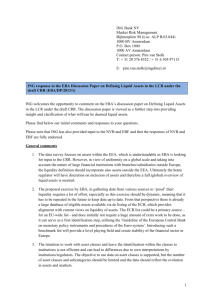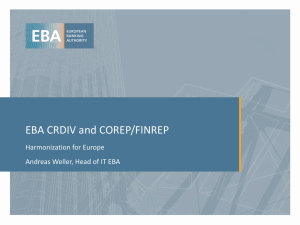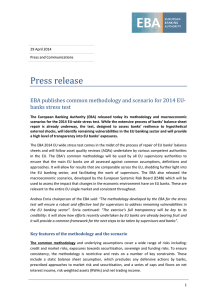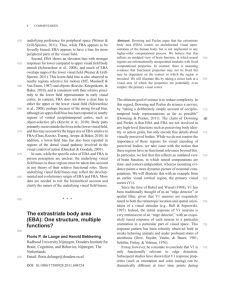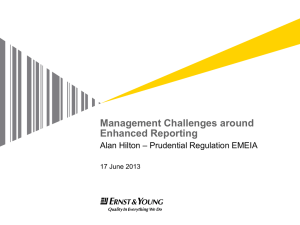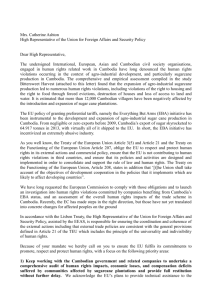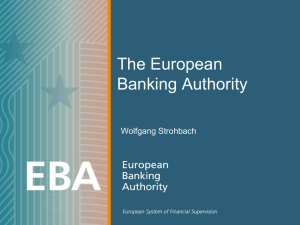Opinion on perimeter of credit institution
advertisement
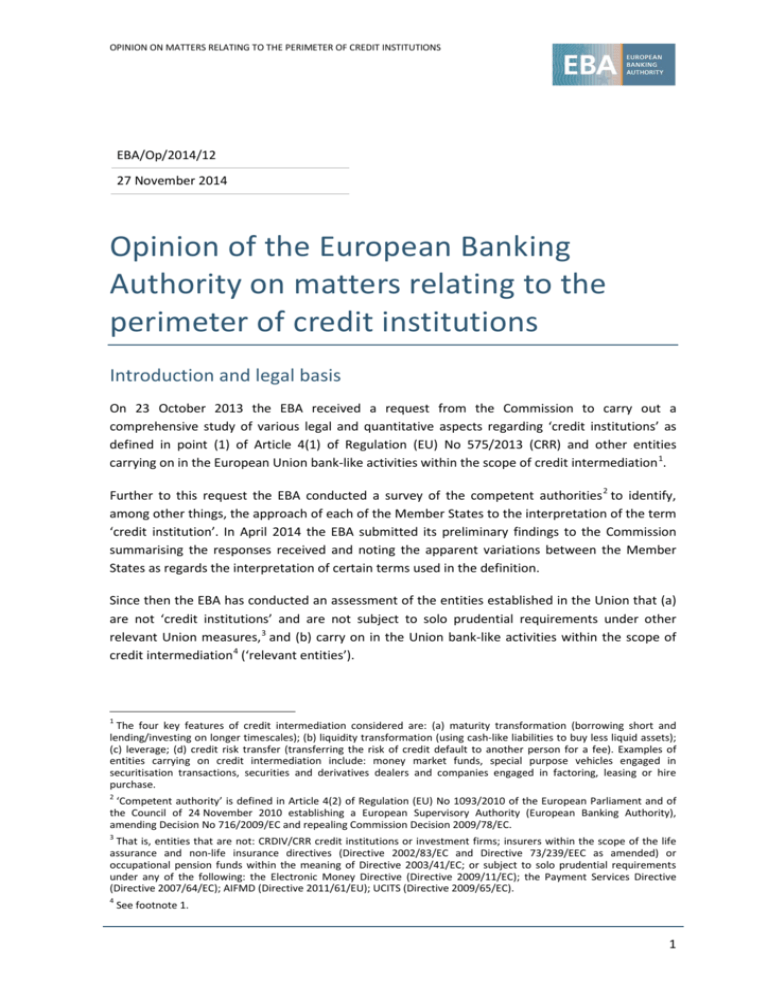
OPINION ON MATTERS RELATING TO THE PERIMETER OF CREDIT INSTITUTIONS EBA/Op/2014/12 27 November 2014 Opinion of the European Banking Authority on matters relating to the perimeter of credit institutions Introduction and legal basis On 23 October 2013 the EBA received a request from the Commission to carry out a comprehensive study of various legal and quantitative aspects regarding ‘credit institutions’ as defined in point (1) of Article 4(1) of Regulation (EU) No 575/2013 (CRR) and other entities carrying on in the European Union bank-like activities within the scope of credit intermediation 1. Further to this request the EBA conducted a survey of the competent authorities 2 to identify, among other things, the approach of each of the Member States to the interpretation of the term ‘credit institution’. In April 2014 the EBA submitted its preliminary findings to the Commission summarising the responses received and noting the apparent variations between the Member States as regards the interpretation of certain terms used in the definition. Since then the EBA has conducted an assessment of the entities established in the Union that (a) are not ‘credit institutions’ and are not subject to solo prudential requirements under other relevant Union measures, 3 and (b) carry on in the Union bank-like activities within the scope of credit intermediation 4 (‘relevant entities’). 1 The four key features of credit intermediation considered are: (a) maturity transformation (borrowing short and lending/investing on longer timescales); (b) liquidity transformation (using cash-like liabilities to buy less liquid assets); (c) leverage; (d) credit risk transfer (transferring the risk of credit default to another person for a fee). Examples of entities carrying on credit intermediation include: money market funds, special purpose vehicles engaged in securitisation transactions, securities and derivatives dealers and companies engaged in factoring, leasing or hire purchase. 2 ‘Competent authority’ is defined in Article 4(2) of Regulation (EU) No 1093/2010 of the European Parliament and of the Council of 24 November 2010 establishing a European Supervisory Authority (European Banking Authority), amending Decision No 716/2009/EC and repealing Commission Decision 2009/78/EC. 3 That is, entities that are not: CRDIV/CRR credit institutions or investment firms; insurers within the scope of the life assurance and non-life insurance directives (Directive 2002/83/EC and Directive 73/239/EEC as amended) or occupational pension funds within the meaning of Directive 2003/41/EC; or subject to solo prudential requirements under any of the following: the Electronic Money Directive (Directive 2009/11/EC); the Payment Services Directive (Directive 2007/64/EC); AIFMD (Directive 2011/61/EU); UCITS (Directive 2009/65/EC). 4 See footnote 1. 1 OPINION ON MATTERS RELATING TO THE PERIMETER OF CREDIT INSTITUTIONS The EBA has not sought to quantify the bank-like activities carried on by relevant entities in the absence of comprehensive quantitative data 5 and in light of the work underway by other EU bodies, in particular the ECB and the ESRB, to determine the size of the shadow banking sector. The EBA is contributing to the workstreams of the ECB and the ESRB, and to wider international workstreams, with a view to coordinating, insofar as possible, the analytical work underway in this area. The EBA’s report, which includes specific observations about the definition of ‘credit institution’ and a factual summary of the responses received from the competent authorities regarding the prudential treatment of relevant entities under national law, is attached to this opinion. The EBA’s competence to deliver an opinion is based on Article 34(1) of Regulation (EU) No 1093/2010, 6 as ‘credit institutions’ come under the EBA’s area of competence. In accordance with Article 14(5) of the Rules of Procedure of the Board of Supervisors, 7 the Board of Supervisors has adopted this opinion. Definition of ‘credit institution’ The term ‘credit institution’ is defined in point (1) of Article 4(1) of the CRR as follows: ‘credit institution’ means an undertaking the business of which is to take deposits or other repayable funds from the public and to grant credits for its own account. The key terms ‘deposits’, ‘other repayable funds’, ‘grant credits’, 'from the public' are not defined in the CRR. Therefore, notwithstanding the inclusion of the definition in a maximum harmonising Regulation, 8 there remains a degree of variation between the Member States as to the interpretation of the term ‘credit institution’ and therefore the entities to which the requirement to obtain a banking licence (and therefore the requirements of the CRDIV 9/CRR) applies in the Member States. The EBA observes that the term ‘credit institution’ is of significance not only for the purposes of determining the entities subject to authorisation and prudential requirements under the CRDIV/CRR but also the entities within the scope of the DGSD (recast) (Directive 2014/49/EU), the Bank Recovery and Resolution Directive (Directive 2014/59/EU), the Single Supervision Mechanism (Regulation (EU) No 1024/2013) and the Single Resolution Mechanism (Regulation 5 The competent authorities do not tend to hold such information nor do they tend to have powers to obtain such information from entities operating outside the regulatory perimeter. 6 See footnote 2. 7 Decision adopting the Rules of Procedure of the European Banking Authority Board of Supervisors of 11 December 2013 (Decision EBA DC 001 (Rev3)). 8 Previously the definition appeared in Directive 2006/48/EC. 9 Directive 2013/36/EU on access to the activity of credit institutions and the prudential supervision of credit institutions and investment firms, amending Directive 2002/87/EC and repealing Directives 2006/48/EC and 2006/49/EC. 2 OPINION ON MATTERS RELATING TO THE PERIMETER OF CREDIT INSTITUTIONS (EU) 806/2014). In light of the weight placed on this term the EBA notes that it is of considerable importance that it is interpreted in a uniform manner across the Union. Although it is not clear from the responses received from the competent authorities whether the existing variations in the interpretation of the term ‘credit institution’ are, in practice, material as regards the number and types of entities which are classified as credit institutions in the Member States, in the EBA’s opinion the fact that there is a risk that the term could be interpreted in an inconsistent way contradicts the very foundation of the single rulebook. In particular, this poses a risk to the consistent application of critical legally binding Union acts intended to protect consumers and investors, enhance financial stability and rebuild trust in the financial system. For this reason the EBA urges the Commission to give consideration to possible clarifications to the definition of ‘credit institution’. The EBA provides in the report some observations as to possible approaches to the clarification of the term ‘credit institution’. These are based on the responses received from the competent authorities. In particular, to support the homogenous interpretation of the term consideration should be given to the development of a definition of: • ‘deposit’ (this could include the following core components: a sum of money; repayable on demand or at a contractually agreed point in time (but otherwise repayment of the principal is unconditional) and with or without interest or a premium; received from third parties [legal or natural persons]; and received in the course of carrying on the activity by way of business, and be subject to a number of exclusions, for example monies referable to the provision of property or services (for example, advance payments under a contract for the sale, hire or other provision of property or services which are repayable only in the event that the property or services are not in fact sold, hired or otherwise provided) or the giving of security could be excluded from the scope of the definition); • ‘other repayable funds’ (this could be defined to include ‘bonds and other comparable securities such as negotiable certificates of deposit’ providing these are continually issued by the entity concerned). Perimeter of ‘credit institution’ At this stage the EBA does not offer any recommendations about the overall perimeter of ‘credit institution’ or the scope of the prudential framework established under Union law, specifically whether this should extend to some or all relevant entities (as defined above) or whether some or all of these entities should be subject to a bespoke set of prudential requirements established under Union law. However, the EBA observes that there is wide variation between the Member States as to the prudential treatment of relevant entities. As illustrated by the data set out in the report, in some Member States relevant entities are treated in the same way as credit institutions and are 3 OPINION ON MATTERS RELATING TO THE PERIMETER OF CREDIT INSTITUTIONS therefore subject to comprehensive solo prudential requirements under national law. In other Member States a lighter touch solo prudential regime or no solo prudential regime is applicable. As the prudential treatment of relevant entities varies between the Member States the EBA observes that there may be merit in the Commission conducting or commissioning further analysis of the sector to determine whether it would be appropriate to put forward any Union legislative proposals with respect to some or all relevant entities. Any such analysis should be undertaken in conjunction with other bodies such as the Financial Stability Board and the Basel Committee on Banking Supervision (BCBS) to ensure appropriate convergence with global standards. The EBA also observes that although some entities carrying on bank-like activities may not be subject to solo prudential requirements, where they are part of a banking group they may fall within the scope of regulatory consolidation (e.g. where they are considered ‘financial institutions’). The EBA observes that work is underway internationally (e.g. by the BCBS) to assess the accounting and regulatory approaches to consolidation and the EBA is participating actively in these workstreams with a view to promoting greater clarity and convergence on the scope of consolidation to mitigate potential risks posed to the financial soundness of banking groups. Finally, the EBA observes that a necessary element of any future work in relation to the shadow banking sector would be to ensure that the perimeter of ‘credit institution’ (and other relevant terms such as ‘financial institution’) is clearly defined. This would complement any definitions introduced in the context of any new legislative proposals considered appropriate as a result of that work. The EBA also refers to its earlier opinion in relation to the Commission’s Green Paper on Shadow Banking. 10 This opinion and the report will be published on the EBA’s website. 10 EBA BS 2012 139 Opinion of the European Banking Authority on the Commission’s Green paper on Shadow Banking. 4
